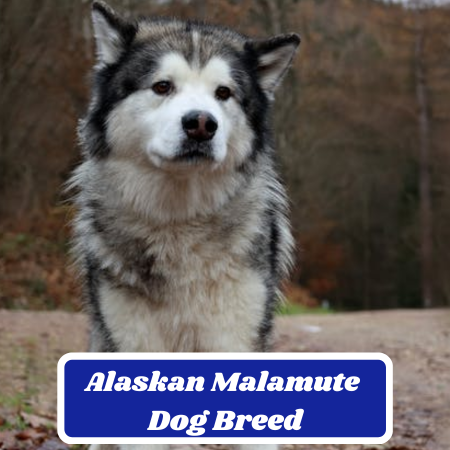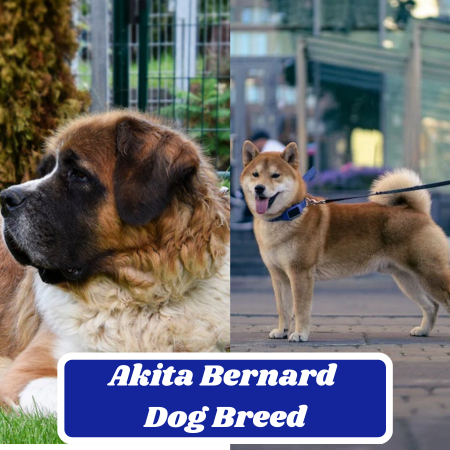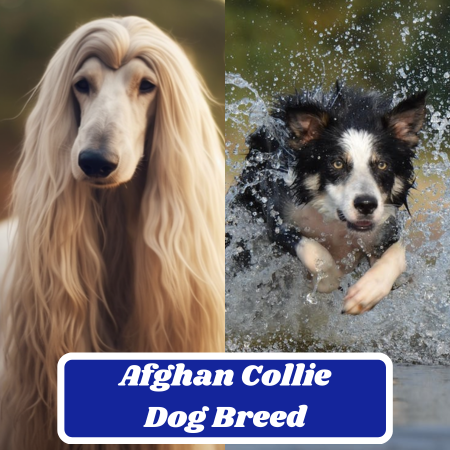Alaskan Malamute Dog Breed: Characteristics, Information & Facts

| Physical Characteristics | Alaskan Malamute |
|---|---|
| Size (inches) | 22-26 inches (58-63.5 cm) |
| Actual Weight | 75-100 pounds (34-39 kg) |
| Life Span | 10-14 years |
| Colors | white, black, gray, sable (a reddish-brown) |
| Type of Coat | Thick, double coat |
| Energy Levels | High energy |
| Healthy Breed | Generally healthy, but prone to certain conditions such as hip dysplasia and bloat |
The Alaskan Malamute dog breed
The Alaskan Malamute is a breed that has been around for thousands of years. Bred for their strength and endurance, these dogs have served as invaluable companions to the indigenous people of Alaska.
They were used for hunting, hauling heavy loads, and even serving as a source of warmth during harsh winters.
The history of the Alaskan Malamute dates back to ancient times when the Mahlemuts tribe in Alaska bred them.
These dogs were highly valued by their owners and treated like family members. They were selectively bred over time for their size, speed, and strength.
Today, the Alaskan Malamute remains a beloved breed known for their striking appearance and affectionate nature.
Their thick coat comes in various shades such as white, black, gray or white.
Regarding temperament, Alaskan Malamutes are known for being loyal and friendly towards their owners while also exhibiting independence.
Their high energy levels require plenty of daily physical activity to keep them mentally and physically stimulated.
One unique trait that sets them apart from other breeds is their pack mentality – they enjoy being part of a group dynamic rather than being alone.
This trait makes them great family pets but also means they may struggle with separation anxiety if left alone for too long. Overall, owning an Alaskan Malamute can be an incredibly rewarding experience due to their gentle nature, striking appearance, and rich history.
However, it’s important to ensure they receive proper training and exercise as well as regular veterinary check-ups due to common health concerns found in the breed such as hip dysplasia or cataracts. In subsequent sections we’ll delve deeper into these topics so you can learn more about what makes this breed so special.
History Of The Alaskan Malamute
The Alaskan Malamute is one of the oldest sled dogs and is believed to be a descendant of the domesticated wolf-dogs that accompanied the first Paleolithic hunters across the Bering Strait from Siberia to America.
The breed was developed by the Mahlemut Eskimo Tribes of Alaska, who bred them as working dogs to pull sleds and hunt. Modern researchers assume that great migrations occurred about 2000 to 3000 years ago, when people from East Asia moved to Alaska and brought their dogs with them.
The Malamute-speaking tribe or tribes eventually settled in the Northeastern area of the Seward Peninsula, where the dogs we call Alaskan Malamutes were developed.
The breed thrives on a diet of wild game and fresh fish rich in protein, which was the traditional diet of the Mahlemut Eskimo Tribes of Alaska.
Physical Characteristics
Size and weight range
The Alaskan Malamute is known for its impressive size and strength. Males typically stand at 24-26 inches tall and weigh between 85-100 pounds, while females are slightly smaller at 22-24 inches tall and weigh between 75-90 pounds.
This breed is considered a large dog, but it’s important to note that their size does not make them an aggressive breed. In fact, they are known for their gentle nature.
Coat color and texture
Another distinctive feature of the Alaskan Malamute is its thick, double-layered coat. The undercoat is dense and woolly, while the outer coat is longer and coarser.
This combination provides excellent insulation against the cold temperatures in which they were originally bred to work. Their coat comes in a variety of colors, including black, gray, sable (a reddish-brown), or a combination of these colors with white.
Distinctive features such as their thick fur, bushy tail, and erect ears
One of the most notable features of the Alaskan Malamute is their thick fur which gives them a plush appearance. Their bushy tail curls over their back and can be used for warmth when sleeping or to cover their nose during blizzards.
Another distinctive feature of this breed are their erect ears which give them an alert expression. In addition to these physical characteristics, the Alaskan Malamute has strong legs with large paws that act like snowshoes providing excellent traction on ice or snow-covered terrain.
These physical attributes make them highly suited for cold climate work such as pulling sleds or carrying heavy loads. Overall, the physical characteristics of the Alaskan Malamute make it clear that this breed was designed to thrive in harsh winter climates.
Their thick fur, bushy tail and erect ears all serve a specific purpose to help them survive in harsh terrain. Their size and strength make them ideal for sledding, hauling and other tasks that require strength and endurance.
Temperament and Personality Traits
| Temperament and Personality Traits | Alaskan Malamute |
|---|---|
| Active and Curious | ⭐⭐⭐⭐ |
| Playfulness | ⭐⭐⭐⭐ |
| Loyal | ⭐⭐⭐⭐ |
| Stubborn | ⭐⭐ |
| Intelligent | ⭐⭐⭐⭐ |
| Energetic | ⭐⭐⭐⭐ |
| Responds Well to Training | ⭐⭐⭐⭐ |
| Good with Children | ⭐⭐⭐⭐ |
| Good for Protection | ⭐⭐⭐ |
| Good with Other Animals | ⭐⭐⭐ |
Affectionate nature towards their owners
Alaskan Malamutes are known for their strong bond with their owners. They thrive on human companionship and love being around people.
They will often follow you around the house, always staying close by your side. This breed is incredibly loyal and affectionate, making them great family pets.
One of the unique things about Alaskan Malamutes is that they have a very expressive face. You can tell how they’re feeling just by looking at them.
When happy, they’ll wag their tail and sometimes even “talk” to you with adorable vocalizations. When upset or anxious, they may whine or pace around.
Independent streak in personality
While Alaskan Malamutes are affectionate towards their owners, they can also have an independent streak in their personality. This means that they are not always interested in obedience training or following commands without question. This independent streak can make training more challenging than it would be with other breeds.
However, it’s important to note that this doesn’t mean that Alaskan Malamutes aren’t intelligent – they’re actually quite clever! It just means that they may need more patience and persistence when it comes to teaching them new things.
High energy levels and need for exercise
Alaskan Malamutes are high-energy dogs that require plenty of exercise to stay healthy and happy.
Daily walks or runs are a must for this breed, as well as ample indoor or outdoor playtime. If an Alaskan Malamute doesn’t get enough exercise, he may become destructive out of boredom or frustration.
This could mean chewing on furniture, digging up the yard, or engaging in other destructive behaviors. It’s important to note that these dogs do not cooped well inside all day.
They need room to roam and stretch their legs.
Strong pack mentality
Alaskan Malamutes have a strong pack mentality, which means they thrive in situations with a clear hierarchy and feel like they are part of a family unit.
They are social creatures that enjoy being around other dogs but may not get along with every dog they meet.
It’s important to socialize your Alaskan Malamute from a young age so that he learns how to interact with other dogs appropriately. This can help prevent any aggression or dominance issues down the line.
Because of their pack mentality, Alaskan Malamutes do not do well when left alone for long periods of time. They need constant companionship and interaction in order to be happy and healthy.
Overall, while these traits make the Alaskan Malamute breed unique and lovable, it’s important for owners to understand them before bringing one into their home. With proper training, exercise, and socialization, an Alaskan Malamute can make a wonderful companion for those who have the time and energy to devote to this beautiful breed.
Apartment Living
Alaskan Malamutes are not recommended for apartment living because they need space to roam and play. They are fairly active indoors and should have at least a large yard.
They are also vocal and can be disruptive to neighbors in an apartment setting. While it is possible for an Alaskan Malamute to live in an apartment, it is not ideal and can lead to behavioral problems if their needs are not met.
It is important to consider the breed’s needs and temperament before bringing an Alaskan Malamute into an apartment.
Health Concerns
| Health Issues | Alaskan Malamute |
|---|---|
| Hip Dysplasia | ⭐⭐⭐⭐ |
| Cataracts | ⭐⭐⭐ |
| Chondrodysplasia (ChD) | ⭐⭐⭐ |
| Gastric Torsion | ⭐ |
| Renal Cortical Hypoplasia | ⭐ |
| Grooming | ⭐⭐⭐ |
| Shedding | ⭐⭐⭐⭐ |
Alaskan Malamutes are generally a healthy breed, but like all dogs, they are prone to certain health issues. It’s important for owners to be aware of these issues and work closely with their veterinarians to ensure the best possible care for their pet.
Common Health Issues in Alaskan Malamutes
Hip dysplasia is one of the most common health concerns in Alaskan Malamutes. This condition occurs when the hip joint doesn’t form properly, leading to arthritis and lameness.
Responsible breeders will screen their dogs for hip dysplasia and only breed those that pass the screening. Cataracts can also occur in Alaskan Malamutes.
This condition causes cloudiness or opacity in the eye’s lens, leading to impaired vision or blindness. Cataracts can be caused by genetics, injury, or aging.
Hypothyroidism is another common health issue in this breed. It occurs when the thyroid gland doesn’t produce enough hormones, which can lead to weight gain, lethargy, and other symptoms.
Hypothyroidism is treatable with medication and regular monitoring by a veterinarian. Other health issues affecting Alaskan Malamutes include bloat (a potentially life-threatening condition where the stomach fills with gas), allergies, and skin problems.
The Importance of Regular Vet Check-Ups
Regular vet check-ups are crucial for maintaining your Alaskan Malamute’s overall health and well-being. During these visits, your vet will examine your dog from head to toe and may recommend additional testing or screening based on his findings. In addition to routine physical exams, your vet may recommend regular bloodwork to check for thyroid function or other potential health concerns.
Regular dental cleanings are also important for preventing dental disease and keeping your dog’s teeth strong and healthy. By working closely with your veterinarian and staying on top of your dog’s health, you can help ensure a long and happy life for your Alaskan Malamute.
Grooming
The Alaskan Malamute has an extremely thick, waterproof double coat that requires daily brushing. Regular brushing is one of the best things you can do to maintain their coat and prevent matting.
They shed heavily twice a year, and during this time, they require more frequent brushing to remove the loose fur. Some owners choose to have their Malamutes professionally groomed during shedding season.
Bathing should be done as needed, but not too frequently as it can strip the natural oils from their coat. Trimming their nails regularly and cleaning their ears to prevent infections is also important.
Many online resources, including videos, provide beginner/basic grooming tips for Alaskan Malamutes.
Training and Exercise Needs
| Training Needs | Alaskan Malamute |
|---|---|
| Trainable | ⭐⭐⭐⭐ |
| Fetch | ⭐⭐⭐ |
| Exercise Needs | ⭐⭐⭐⭐⭐ |
| Exercise per Day | At least 1-2 hours |
Importance of Early Socialization
The Alaskan Malamute breed is known for their pack mentality, which means they thrive in social settings. It’s essential to start socializing your pup early on to prevent any potential behavioral issues. Introducing them to other dogs, children, and new environments will help them feel comfortable and confident in different situations.
Your Malamute should learn basic obedience commands such as sit, stay, come, and leave it. It’s important to use positive reinforcement training methods instead of punishment-based techniques.
The breed responds well to rewards like treats or verbal praise. One way to socialize your pup is through puppy training classes.
These classes offer a great opportunity for your dog to interact with other puppies while learning basic obedience skills. Additionally, the classes provide an opportunity for you as an owner to learn how to train your dog effectively.
Need for Daily Exercise
The Alaskan Malamute is a highly active breed that requires daily exercise. Without enough physical activity, they can become bored and destructive.
A bored Malamute may resort to destructive behaviors such as chewing or digging. As a general rule, adult Malamutes require at least 30-60 minutes of exercise each day.
Depending on your dog’s age and energy level, you may need more time dedicated to physical activity.
Malamutes thrive off outdoor activities such as hiking or running alongside their owners’ bicycles.
They enjoy playing fetch or participating in agility courses as well. Engaging in physical activities with your dog can strengthen the bond between you two while providing them with necessary stimulation.
It’s important not only to meet their exercise needs but also ensure they have access to plenty of water during these activities due t the thick fur this breed has that can make it difficult for them when hot outside.
Early socialization and obedience training are essential to raising a well-behaved Alaskan Malamute.
Daily exercise is necessary to prevent boredom and destructive behaviors.
By providing your Malamute with the right amount of physical activity, you can ensure they’re happy, healthy, and well-adjusted members of your family.
Living with an Alaskan Malamute
| Diet Needs | Alaskan Malamute |
|---|---|
| Protein | ⭐⭐⭐⭐ |
| Vitamins and Minerals | ⭐⭐⭐⭐ |
| Carbohydrates | ⭐⭐ |
| Feeding Frequency | ⭐⭐⭐ |
| Amount of Food | ⭐⭐⭐ |
| Grooming | ⭐⭐⭐ |
| Shedding | ⭐⭐⭐⭐ |
| Drooling | ⭐ |
Feeding
Alaskan Malamutes can be fed either a simple dry dog food diet or a combo diet consisting of 1/2 premium dry dog food, 1/4 fresh meat/fish, and 1/4 veggies/fruit.
They require a balanced diet that is rich in protein, vitamins, and minerals. Adult Alaskan Malamutes should be fed between 3-5 cups of high-quality dog food daily depending on their size, weight, age, and activity level.
They enjoy fish and other meats, and adding a couple of tablespoons of canned mackerel or tuna several times a week can help prevent coat and skin problems.
Alaskan Malamutes should be fed twice a day to prevent overeating and obesity, and puppies should have four small meals per day. It is important to measure and space out their meals properly.
Alaskan Malamutes have a unique metabolism, and their diet should be tailored to their specific needs.
It is also important to avoid feeding them foods that harm their health.
Ideal living situation for the breed (e.g., large yard or open space)
Alaskan Malamutes are a large and active breed that requires a lot of space to move around and play. As such, they are well-suited to living in homes with large yards or open spaces where they can run and play freely.
Ideally, a fenced-in yard would be ideal for this breed as it allows them to explore their surroundings without the risk of running away. It is important to note that Alaskan Malamutes do not do well in apartments or small living spaces.
They need room to stretch their legs and move around, especially since they have a high energy level that needs to be expended daily.
If you live in an apartment, make sure you take your Alaskan Malamute out for regular walks and exercise sessions.
Compatibility with children or other pets in the household
Alaskan Malamutes are known for being affectionate and loyal towards their owners and family members. As such, they typically get along well with children, especially if they are socialized early on.
However, it is important to supervise interactions between children and dogs at all times as even the most gentle dog can become agitated if provoked.
When it comes to other pets in the household, Alaskan Malamutes can be territorial towards dogs of the same sex so introducing them slowly is recommended.
They also have high prey drive, so they may not be suitable for homes with smaller animals like cats or rabbits. Overall, compatibility will depend on your individual dog’s temperament and personality traits so it’s important to monitor interactions carefully during introductions.
The Importance of Exercise
As mentioned previously, Alaskan Malamutes have high energy levels, so they need daily exercise to remain healthy and happy.
This breed is well-suited to activities like hiking, running, and swimming as they enjoy being outdoors and exploring their surroundings.
It’s important to note that Alaskan Malamutes can become destructive if they are not given an outlet for their energy. This means that regular exercise sessions are crucial for preventing destructive behavior like chewing on furniture or digging up the yard.
Training and Socialization
Alaskan Malamutes have a strong independent streak, which can sometimes make training challenging.
However, early socialization and obedience training can help prevent behavioral issues down the line. Training should be approached with patience and positive reinforcement techniques as this breed does not respond well to harsh or aggressive training methods.
The Role of Routine Vet Check-Ups
Like all breeds, Alaskan Malamutes are prone to certain health issues such as hip dysplasia, cataracts, and hypothyroidism. Regular vet check-ups can help catch these issues early on before they become more serious.
It’s important to establish a relationship with a trusted veterinarian who understands the unique needs of this breed. They can provide guidance on diet, exercise, and other healthcare needs specific to Alaskan Malamutes.
Conclusion
The Alaskan Malamute is a beloved breed for many reasons. They are intelligent, loyal, and have a natural instinct to work alongside their human companions.
Their thick fur, bushy tails, and erect ears give them a distinctive, recognizable appearance.
While they might not be the right fit for every family or household, those who do take on the responsibility of living with an Alaskan Malamute will find themselves with a loving and energetic companion.
Throughout this article, we’ve explored some of the key traits and characteristics of the Alaskan Malamute breed.
From their physical appearance to their temperament and health concerns, there’s a lot to consider before bringing one into your home.
But for those who are willing to put in the time and effort needed to care for an Alaskan Malamute properly, it can be an incredibly rewarding experience.
One of the most important things to keep in mind when considering an Alaskan Malamute as part of your family is their high energy levels.
These dogs need plenty of exercise each day in order to stay healthy and happy.
This could mean long walks or hikes outdoors or even participating in dog sports like agility training or weight pulling competitions. Another crucial factor is socialization and training.
Early socialization can help prevent behavioral issues down the line while obedience training will help you establish yourself as the pack leader in your household. Fortunately, these dogs are highly trainable and enjoy working alongside their owners.
It’s also important to note that while Alaskan Malamutes are generally affectionate towards their owners and make great family pets when raised appropriately, they have an independent personality streak that can sometimes make them difficult for first-time dog owners.
Overall, if you’re looking for a loyal companion who loves outdoor adventures as much as you do, an Alaskan Malamute might be the perfect breed.
Just be sure to research beforehand and ensure you’re up for the challenge of caring for such an active and independent dog.
With the right care, love, and attention, an Alaskan Malamute can be a wonderful addition to any family or household.





